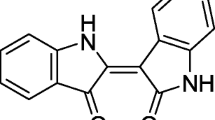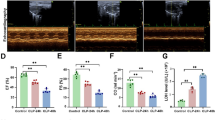Abstract
Background
The specific and accurate pathogenesis of diarrhea-type irritable bowel syndrome is still unclear.
Aims
We explored the mechanism of heat shock protein 27 (HSP27) in diarrhea-type irritable bowel syndrome to identify the key targets for the disease.
Methods
The human colonic epithelial cell lines Caco-2 and NCM460 were pretreated with KRIBB3 (a phosphorylation inhibitor of HSP27) and then stimulated with lipopolysaccharide for different times. The apoptosis ratios of Caco-2 and NCM460 cells were examined with Annexin V/PI assays. Cell growth was determined using the cell counting kit-8 assay, and the expression levels of IL-1β and IL-6 in the cell supernatant were analyzed by ELISA. In addition, the expression levels of HSP27 and the nuclear factor-κB (NF-κB) signaling pathway were examined by Western blot assay.
Results
Stimulation with lipopolysaccharide promoted the expression of HSP27 in colonic epithelial cells. HSP27 was phosphorylated at serine 78 and 82 after exposure to LPS. Apoptosis, growth inhibition, and inflammatory factor expression of lipopolysaccharide-induced colonic epithelial cells were greatly exacerbated by KRIBB3 treatment. In addition, KRIBB3 inhibited the phosphorylation of IκB-α and the activation of NF-κB. Gene silencing by small interfering RNA indicated that phosphorylation of HSP27 may regulate the NF-κB pathway.
Conclusions
HSP27 plays an important role in the inflammatory response of intestinal human colonic epithelial cells. HSP27 may protect intestinal epithelial cells against damage by regulating the NF-κB pathway.




Similar content being viewed by others
References
Buckley MM, O’Mahony SM, O’Malley D. Convergence of neuroendocrine-immune pathways in the pathophysiology of irritable bowel syndrome. World J Gastroenterol. 2014;20:8846–8858.
Su AM, Shih W, Presson AP, et al. Characterization of symptoms in irritable bowel syndrome with mixed bowel habit pattern. Neurogastroenterol Motil. 2014;26:36–45.
Matuchansky C. Irritable bowel syndrome: modern concepts and management options. Am J Med. 2016;129:e39.
Schweiger T, Nikolowsky C, Starlinger P, et al. Stromal expression of heat-shock protein 27 is associated with worse clinical outcome in patients with colorectal cancer lung metastases. PLoS ONE. 2015;10:e0120724.
Khan R, Siddiqui NN, UI Haq A, et al. Introducing differential expression of human heat shock protein 27 in hepatocellular carcinoma: moving toward identification of cancer biomarker. Tumour Biol. 2016;37:715–721.
Heidari-Bakavoli AR, Sahebkar A, Mobara N, et al. Changes in plasma level of heat shock protein 27 after acute coronary syndrome. Angiology. 2012;63:12–16.
Deng W, Zhang Y, Gu L, et al. Heat shock protein 27 downstream of P38-PI3K/Akt signaling antagonizes melatonin-induced apoptosis of SGC-7901 gastric cancer cells. Cancer Cell Int. 2016;16:5.
Kammanadiminti SJ, Chadee K. Suppression of NF-kappa B activation by Entamoeba histolytica in intestinal epithelial cells is mediated by heat shock protein 27. J Biol Chem. 2006;281:26112–26120.
Guo X, Yang Y, Luo Y. Screening and identification of anomously expressed proteins colon mucosa in diarrhea-predominant irritable bowel syndrome. Med J Lib Army. 2007;32:1257–1259.
Bhattacharyya S, Borthakur A, Pant N, Dudeja PK, et al. Bcl10 mediates LPS-induced activation of NF-kappaB and IL-8 in human intestinal epithelial cells. Am J Physiol Gastrointest Liver Physiol. 2007;293:G429–G437.
Jobin C, Sartor RB. The I kappa B/NF-kappa B system: a key determinant of mucosal inflammation and protection. Am J Physiol Cell Physiol. 2000;278:C451–C462.
McAllister-Lucas LM, Ruland J, Siu K, et al. CARMA3/Bcl10/MALT1-dependent NFkappaB activation mediates angiotensin II-responsive inflammatory signaling in nonimmune cells. Proc Natl Acad Sci U S A. 2007;104:139–144.
Park KJ, Gaynor RB, Kwak YT. Heat shock protein 27 association with the I kappa B kinase complex regulates tumor necrosis factor alpha-induced NF-kappa B activation. J Biol Chem. 2003;278:35272–35278.
Bhattacharyya S, Dudeja PK, Tobacman JK. ROS, Hsp27, and IKKbeta mediate dextran sodium sulfate (DSS) activation of IkappaBa, NFkappaB, and IL-8. Inflamm Bowel Dis. 2009;15:673–683.
Kostenko S, Moens U. Heat shock protein 27 phosphorylation: kinases, phosphatases, functions and pathology. Cell Mol Life Sci. 2009;66:3289–3307.
Acunzo J, Katsogiannou M, Rocchi P. Small heat shock proteins HSP27 (HspB1), alphaB-crystallin (HspB5) and HSP22 (HspB8) as regulators of cell death. Int J Biochem Cell Biol. 2012;44:1622–1631.
VanderHeide RS. Increased expression of HSP27 protects canine myocytes from simulated ischemia-reperfusion injury. Am J Physiol Heart Circ Physiol. 2002;282:H935–H941.
Sur R, Lyte PA, Southall MD. Hsp27 regulates pro-inflammatory mediator release in keratinocytes by modulating NF-kappaB signaling. J Invest Dermatol. 2008;128:1116–1122.
Jin C, Cleveland JC, Ao L, et al. Human myocardium releases heat shock protein 27 (HSP27) after global ischemia: the proinflammatory effect of extracellular HSP27 through toll-like receptor (TLR)-2 and TLR4. Mol Med. 2014;20:280–289.
Miller-Graziano CL, De A, Laudanski K, Herrmann T, Bandyopadhyay S. HSP27: an anti-inflammatory and immunomodulatory stress protein acting to dampen immune function. Novartis Found Symp. 2008;291:196–208.
Ruan J, Qi Z, Shen L, et al. Crosstalk between JNK and NF-κB signaling pathways via HSP27 phosphorylation in HepG2 cells. Biochem Biophys Res Commun. 2015;456:122–128.
Funding
This study was funded by the General Program of the National Natural Science Foundation of China (Grant No. 8167032057).
Author information
Authors and Affiliations
Contributions
LHC and YJZ conceived and designed the experiments; YJZ, CL, and YZ performed the experiments; XHW, YJZ, and ZHY analyzed the data; LHC and YJZ wrote the paper; LHC, SXW, and YJZ revised the manuscript. All authors have reviewed and approved the final manuscript to be submitted for publication.
Corresponding author
Ethics declarations
Conflict of interest
The authors declare that they have no conflicts of interest.
Additional information
Publisher's Note
Springer Nature remains neutral with regard to jurisdictional claims in published maps and institutional affiliations.
Rights and permissions
About this article
Cite this article
Zhang, Y., Wang, X., Wang, S. et al. Heat Shock Protein 27 Regulates the Inflammatory Response of Intestinal Epithelial Cells by the Nuclear Factor-κB Pathway. Dig Dis Sci 65, 3514–3520 (2020). https://doi.org/10.1007/s10620-020-06074-z
Received:
Accepted:
Published:
Issue Date:
DOI: https://doi.org/10.1007/s10620-020-06074-z




